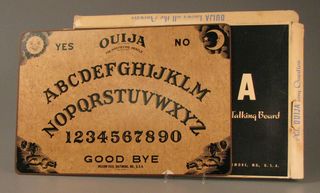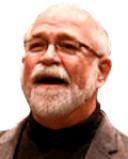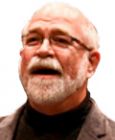Spirituality
The Ouija Board Explained
Explaining the Ouija Board requires insights from history and psychology.
Posted May 16, 2012 Reviewed by Davia Sills

At the twilight of the Victorian Age, hypnotists entertained audiences with their mysterious arts, seemingly severing the connection between will and mind in hapless volunteers. Groups gathered for séances, too, where, more ominously, charlatans purported to communicate with the dead.
Hélène Smith, a famous Hungarian medium, made a fortune on the strength of her claim that she could communicate with Martians. (In the light of day, alas, the Martian language turned out to look suspiciously like French.) Mme. Smith made her start in 1891, the same year the Ouija Board was first patented.
Ouija successfully rode the wave of spiritualism that was sweeping through Europe. When Ouija debuted in the United States, advertisers promised that the game would deliver an “intelligent answer to any question,” and, right in step with the spirit of the times, they guaranteed surpassing effects in “mind-reading,” “second sight,” and “clairvoyance.” Moving a heart-shaped “planchette”—a sort of pencil on rollers—across the Ouija Board printed with an alphabet, the numbers 0-9, and "Yes" and "No" options allowed players to spell out and compile apparently un-sourced answers.
Mysterious at the time, the game still exerts an uncanny effect. But today, most people are unable to naively play the game, because after its debut, Sigmund Freud’s “discovery of the unconscious” fundamentally changed our orientation to our deepest thoughts and emotions. His therapeutic method sometimes included free association (not so unlike playing with an Ouija Board). But Freud claimed our hidden thoughts for science in the interest of therapy; the irrational, he insisted, would yield to rational explanation. “Where id was, there ego shall be,” he famously asserted. But the Ouija Board, by contrast, stands as a relic of that era when popular uneasiness grew proportionately, just as modern empirical science gained in confidence and explanatory power.
Revolutions always leave some people behind—the scientific revolution especially so—and catching up to leading thoughts often takes a long time, because some cling to belief, in this case, an old belief. Today’s marketing of a glow-in-the-dark Ouija Board claims that it has been “a mystery for over 30 years!” However, the first versions of the Ouija Board—in the form of “exploring pendulums” or “diviners”—appeared in Europe more than 1,600 years ago and possibly 1,500 years earlier in China. But the oracles of old likely possessed little clue about how their magical equipment really worked.
The Ouija Board’s continued success depends on two things, neither of them a secret or arising from malign spirits. The first factor is the participants’ suspension of disbelief coupled with clever deception in manipulating the planchette: Say it another way, “play.” Sometimes, of course, the answers that players hope for are an open secret, and fellow game players cooperate to help fulfill a wish. Ouija players know this kind of insider conspiracy well.
Secondly, the Ouija Board—which acts inside the compelling liminal space between physical and mental phenomenon—works by harnessing a much less well-known psycho-physiological principle called "ideomotor action." William Benjamin Carpenter, a British physiologist, introduced this theory as far back as 1852; later, Harvard physician William James popularized the explanation in his 1890 book, Principles of Psychology.
Here’s how ideomotor action works. The planchette may seem to drag our hands along as it selects letters that spell out words, but it happens that muscular action does not always arise out of deliberate will or volition or, in fact, even upon our awareness. Our keen expectations for a certain outcome will sometimes direct the movements of our arms and hands as the planchette glides easily on felt-covered feet. This happens at a level that lies below our conscious attention. “Dousing” sticks or “divining” rods, which also appear to move strangely on their own, work in exactly this way by amplifying muscle movements.
Whether we’re looking for buried pipes or for answers, though, subtle, unacknowledged suggestions, not spirits, guide our actions. Yes, we select the letters ourselves in this game; it’s just that sometimes we don’t quite know that we do it—or how we do it.

It’s fun and usually harmless to indulge a spooky Ouija Board fantasy about just who is moving that thing. Pretending is fun. But some take playing this game too far into the realm of belief, investing the world with unseen manipulators and leaving play far behind.
I’ve written about the Ouija Board before, and afterward, I heard plenty from an adamant few who didn’t like the news that there are no such things as ghosts. In response, I offered them this simple test of paranormal claims. Try inviting the Ouija believer to wear a blindfold, then quietly rotate the game a half turn. Then ask some mischievous questions of your own devising. (Be nice, now.) If your subject has memorized the position of the letters or the "Yes" and "No" answers (on purpose or not), I promise you amusing and instructive results.


